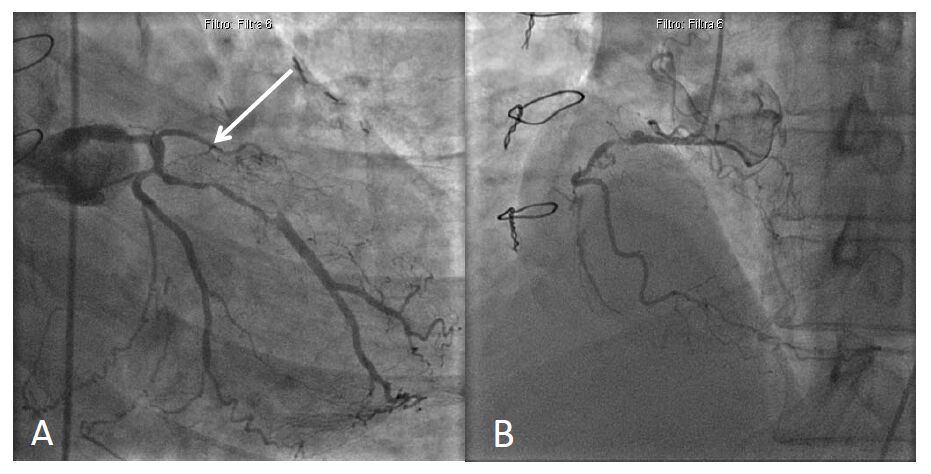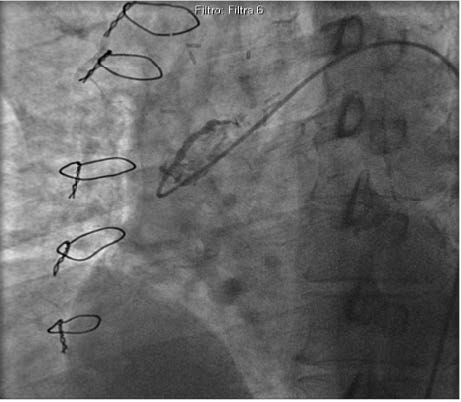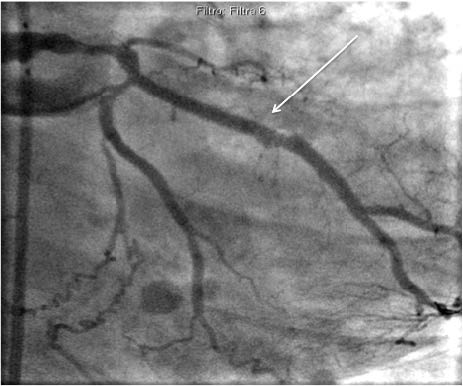Case report
Special Issues
Percutaneous Coronary Intervention in a Patient with Acute Thrombosis of Saphenous Vein Graft and Patent Native Coronary Artery: Which is the Vessel to Approach?
-
Division of Cardiology, Department of Advanced Biomedical Sciences, School of Medicine, "Federico II" University, Naples, Italy
-
Received:
12 June 2015
Accepted:
15 September 2015
Published:
22 September 2015
-
-
-
-
We describe a case of a patient with a clinical history of coronary artery disease, previously treated by coronary surgery and, one year later, by percutaneous coronary intervention plus stenting for sub-occlusive disease of the saphenous vein graft to first obtuse marginal (OM) branch. The patient, admitted to our emergency room with chest pain, nausea, hypotension and diaphoresis, had elevated blood levels of cardiac troponin T and EKG showed elevation of the ST segment in the in lateral leads, suggesting a diagnosis of ST elevated myocardial infarction (STEMI). Thus, coronary angiography was immediately performed, showing the massive thrombosis of the saphenous vein graft previously treated by stenting and the slight patency of the native vessel. We decided to approach the native vessel instead of clashing to the massive thrombus of the saphenous vein graft, overcoming the actual guidelines indications.
Citation: Marco Ferrone, Anna Franzone, Bruno Trimarco, Giovanni Esposito, Plinio Cirillo. Percutaneous Coronary Intervention in a Patient with Acute Thrombosis of Saphenous Vein Graft and Patent Native Coronary Artery: Which is the Vessel to Approach?[J]. AIMS Medical Science, 2015, 2(4): 310-315. doi: 10.3934/medsci.2015.4.310
Related Papers:
| [1] |
Chentong Li, Jinyan Wang, Jinhu Xu, Yao Rong .
The Global dynamics of a SIR model considering competitions among multiple strains in patchy environments. Mathematical Biosciences and Engineering, 2022, 19(5): 4690-4702.
doi: 10.3934/mbe.2022218
|
| [2] |
Xue-Zhi Li, Ji-Xuan Liu, Maia Martcheva .
An age-structured two-strain epidemic model
with super-infection. Mathematical Biosciences and Engineering, 2010, 7(1): 123-147.
doi: 10.3934/mbe.2010.7.123
|
| [3] |
Matthew D. Johnston, Bruce Pell, David A. Rubel .
A two-strain model of infectious disease spread with asymmetric temporary immunity periods and partial cross-immunity. Mathematical Biosciences and Engineering, 2023, 20(9): 16083-16113.
doi: 10.3934/mbe.2023718
|
| [4] |
Ali Mai, Guowei Sun, Lin Wang .
The impacts of dispersal on the competition outcome of multi-patch competition models. Mathematical Biosciences and Engineering, 2019, 16(4): 2697-2716.
doi: 10.3934/mbe.2019134
|
| [5] |
Abdelrazig K. Tarboush, Jing Ge, Zhigui Lin .
Coexistence of a cross-diffusive West Nile virus model in a heterogenous environment. Mathematical Biosciences and Engineering, 2018, 15(6): 1479-1494.
doi: 10.3934/mbe.2018068
|
| [6] |
Azmy S. Ackleh, Mark L. Delcambre, Karyn L. Sutton, Don G. Ennis .
A structured model for the spread of Mycobacterium marinum: Foundations for a numerical approximation scheme. Mathematical Biosciences and Engineering, 2014, 11(4): 679-721.
doi: 10.3934/mbe.2014.11.679
|
| [7] |
Nancy Azer, P. van den Driessche .
Competition and Dispersal Delays in Patchy Environments. Mathematical Biosciences and Engineering, 2006, 3(2): 283-296.
doi: 10.3934/mbe.2006.3.283
|
| [8] |
Junjing Xiong, Xiong Li, Hao Wang .
The survival analysis of a stochastic Lotka-Volterra competition model with a coexistence equilibrium. Mathematical Biosciences and Engineering, 2019, 16(4): 2717-2737.
doi: 10.3934/mbe.2019135
|
| [9] |
Yanxia Dang, Zhipeng Qiu, Xuezhi Li .
Competitive exclusion in an infection-age structured vector-host epidemic model. Mathematical Biosciences and Engineering, 2017, 14(4): 901-931.
doi: 10.3934/mbe.2017048
|
| [10] |
Azmy S. Ackleh, Shuhua Hu .
Comparison between stochastic and deterministic selection-mutation models. Mathematical Biosciences and Engineering, 2007, 4(2): 133-157.
doi: 10.3934/mbe.2007.4.133
|
-
Abstract
We describe a case of a patient with a clinical history of coronary artery disease, previously treated by coronary surgery and, one year later, by percutaneous coronary intervention plus stenting for sub-occlusive disease of the saphenous vein graft to first obtuse marginal (OM) branch. The patient, admitted to our emergency room with chest pain, nausea, hypotension and diaphoresis, had elevated blood levels of cardiac troponin T and EKG showed elevation of the ST segment in the in lateral leads, suggesting a diagnosis of ST elevated myocardial infarction (STEMI). Thus, coronary angiography was immediately performed, showing the massive thrombosis of the saphenous vein graft previously treated by stenting and the slight patency of the native vessel. We decided to approach the native vessel instead of clashing to the massive thrombus of the saphenous vein graft, overcoming the actual guidelines indications.
References
|
[1]
|
Yap CH, Sposato L, Akowuah E, et al. (2009) Contemporary results show repeat coronary artery bypass grafting remains a risk factor for operative mortality. Ann Thorac Surg 87(5): 1386-1391.
|
|
[2]
|
Sarwar B, Brener SJ (2014) Saphenous vein graft interventions. Curr Treat Options Cardiovasc Med 16(5): 301.
|
|
[3]
|
Brilakis ES, Lichtenwalter C, Abdel-karim AR, et al. (2011) Continued benefit from paclitaxel-eluting compared with bare-metal stent implantation in saphenous vein graft lesions during long-term follow-up of the SOS (Stenting of Saphenous Vein Grafts) trial. JACC Cardiovasc Interv 4(2): 176-182.
|
|
[4]
|
Xanthopoulou I, Davlouros P, Tsigkas G, et al. (2011) Long-term clinical outcome after percutaneous coronary intervention in grafts vs native vessels in patients with previous coronary artery bypass grafting. Can J Cardiol 27(6): 716-724.
|
|
[5]
|
Hoffmann R, Nitendo G, Deserno V, et al. (2010) Follow-up results after interventional treatment of infarct-related saphenous vein graft occlusion. Coron Artery Dis 21(2): 61-64.
|
|
[6]
|
Yeh RW, Sidney S, Chandra M, et al. (2010) Population trends in the incidence and outcomes of acute myocardial infarction. N Engl J Med 362(23): 2155-2165.
|
|
[7]
|
Abdel-Karim AR, Banerjee S, Brilakis ES (2010) Percutaneous intervention of acutely occluded saphenous vein grafts: contemporary techniques and outcomes. J Invasive Cardiol 22(6): 253-257.
|
|
[8]
|
Gaglia MA, Torguson R, Xue Z, et al. (2011) Outcomes of patients with acute myocardial infarction from a saphenous vein graft culprit undergoing percutaneous coronary intervention. Catheter Cardiovasc Interv 78(1): 23-29.
|
|
[9]
|
Mehilli J, Pache J, Abdel-Wahab M, et al. (2011) Drug-eluting versus bare-metal stents in saphenous vein graft lesions (ISAR-CABG): a randomised controlled superiority trial. Lancet 378(9796): 1071-1078.
|
|
[10]
|
Vermeersch P, Agostoni P, Verheye S, et al. (2007) Increased late mortality after sirolimus-eluting stents versus bare-metal stents in diseased saphenous vein grafts: results from the randomized DELAYED RRISC Trial. J Am Coll Cardiol 50(3): 261-267.
|
|
[11]
|
Costopoulos C, Latib A, Naganuma T, et al. (2013) Comparison of first- and second-generation drug-eluting stents in saphenous vein grafts used as aorto-coronary conduits. Am J Cardiol 112(3): 318-322.
|
|
[12]
|
Taniwaki M, Räber L, Magro M, et al. (2014) Long-term comparison of everolimus-eluting stents with sirolimus- and paclitaxel-eluting stents for percutaneous coronary intervention of saphenous vein grafts. EuroIntervention 9(12): 1432-1434.
|
|
[13]
|
Kitabata H, Loh JP, Pendyala LK, et al. (2013) Two-year follow-up of outcomes of second-generation everolimus-eluting stents versus first-generation drug-eluting stents for stenosis of saphenous vein grafts used as aortocoronary conduits. Am J Cardiol 112(1): 61-67.
|
-
-
This article has been cited by:
| 1.
|
Yixiang Wu, Necibe Tuncer, Maia Martcheva,
Coexistence and competitive exclusion in an SIS model with standard incidence and diffusion,
2017,
22,
1553-524X,
1167,
10.3934/dcdsb.2017057
|
|
| 2.
|
Junping Shi, Yixiang Wu, Xingfu Zou,
Coexistence of Competing Species for Intermediate Dispersal Rates in a Reaction–Diffusion Chemostat Model,
2020,
32,
1040-7294,
1085,
10.1007/s10884-019-09763-0
|
|
| 3.
|
Yixiang Wu, Xingfu Zou,
Asymptotic profiles of steady states for a diffusive SIS epidemic model with mass action infection mechanism,
2016,
261,
00220396,
4424,
10.1016/j.jde.2016.06.028
|
|
| 4.
|
Lin Zhao, Zhi-Cheng Wang, Shigui Ruan,
Dynamics of a time-periodic two-strain SIS epidemic model with diffusion and latent period,
2020,
51,
14681218,
102966,
10.1016/j.nonrwa.2019.102966
|
|
| 5.
|
Jing Ge, Ling Lin, Lai Zhang,
A diffusive SIS epidemic model incorporating the media coverage impact in the heterogeneous environment,
2017,
22,
1553-524X,
2763,
10.3934/dcdsb.2017134
|
|
| 6.
|
Yuan Lou, Rachidi B. Salako,
Control Strategies for a Multi-strain Epidemic Model,
2022,
84,
0092-8240,
10.1007/s11538-021-00957-6
|
|
| 7.
|
Jinsheng Guo, Shuang-Ming Wang,
Threshold dynamics of a time-periodic two-strain SIRS epidemic model with distributed delay,
2022,
7,
2473-6988,
6331,
10.3934/math.2022352
|
|
| 8.
|
Rachidi B. Salako,
Impact of population size and movement on the persistence of a two-strain infectious disease,
2023,
86,
0303-6812,
10.1007/s00285-022-01842-z
|
|
| 9.
|
Yuan Lou, Rachidi B. Salako,
Mathematical analysis of the dynamics of some reaction-diffusion models for infectious diseases,
2023,
370,
00220396,
424,
10.1016/j.jde.2023.06.018
|
|
| 10.
|
Jonas T. Doumatè, Tahir B. Issa, Rachidi B. Salako,
Competition-exclusion and coexistence in a two-strain SIS epidemic model in patchy environments,
2023,
0,
1531-3492,
0,
10.3934/dcdsb.2023213
|
|
| 11.
|
Azmy S. Ackleh, Nicolas Saintier, Aijun Zhang,
A multiple-strain pathogen model with diffusion on the space of Radon measures,
2025,
140,
10075704,
108402,
10.1016/j.cnsns.2024.108402
|
|
| 12.
|
Jamal Adetola, Keoni G. Castellano, Rachidi B. Salako,
Dynamics of classical solutions of a multi-strain diffusive epidemic model with mass-action transmission mechanism,
2025,
90,
0303-6812,
10.1007/s00285-024-02167-9
|
|
-
-















 DownLoad:
DownLoad: